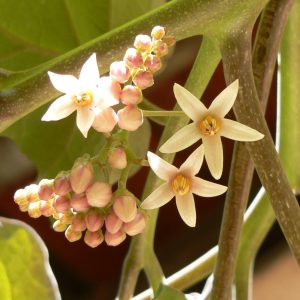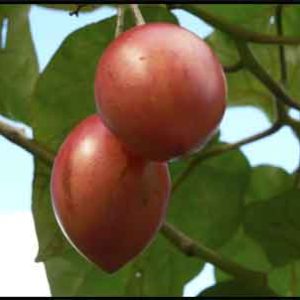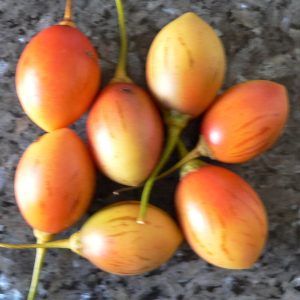Solanum (Cyphomandra) betaceum (betacea)
Tamarillo, tree tomato
Origin
Native to the highlands of northern South America. It is now grown in many sub-tropical countries but only New Zealand and a few areas of South America have commercial operations of significance.
Climate
Tamarillo is a sub-tropical species that grows in areas with rainfall of 600-4000mm pa and annual temperatures of 1525°C. It will also grow in more tropical areas with sufficient elevation, 1000-3000m. Young plants will not withstand frost; more mature plants may lose their foliage if it is light or be killed if heavier or more frequent. Climates conducive to citrus culture support tamarillo. Humid environments increase disease load.
Plant Description
It is a short-lived fast-growing softwood small tree, 1.5-5m high, that has a shallow root system. The fragile trunk and branches break easily if subjected to much stress. The simple alternate axillary heart-shaped leaves are evergreen or deciduous depending on climate, very large, 20-40cm long and 20-35cm wide, and have a soft hairy covering on the underside. Tamarillo forms an endo-mycorrhizal association which considerably improves nutrient supply and the ability to withstand nematode infections.
Relatives
Solanaceae Family. Related to casana, tomato, Cape gooseberry, pepino, naranjilla and many more.
Soils
Best yields are obtained in deep fertile soils, but generally it is not an exacting plant provided drainage is good. Almost any waterlogging will seriously harm or kill the tree. A wide soil pH range is tolerated, 5-8.5.
Propagation
Seed or cuttings are used without any particular problems. Seedling grown trees will have a taller form whereas those from cuttings will be shorter and more bushy. Vegetative propagation by cuttings has the normal advantage of preserving favoured tree characteristics, but can pass on viral infections. Seedlings come through reasonably true to type. For continuous production, renewal plants should be available because trees are productive for only about 8 years, usually succumbing to viral infections.
Cultivars
There are many named varieties which basically have resulted from selection rather than systematic breeding programs. The species is still relatively undeveloped as a horticultural crop.
Some cvs are Goldmine, Inca Gold, Red Delight, and Rothamer. It can be difficult to source some of these as Nursery stocks are often seedlings or cuttings from unknown plants.
Flowering and Pollination
Cool temperatures promote flowering. Flowers occur in groups of 3-10 in axillary cymes or racemes near the ends of branches. The fragrant, self-pollinating flowers have a pink-white corolla and 5 stamens with yellow anthers that are attractive to insects. Flowers open sequentially over a period of days within an inflorescence. Pollination is achieved by bees but wind can contribute if it is strong enough to shake the flowers. Fruit set is initially 12% but only 3% may be carried through to maturity, so that each inflorescence may ultimately bear 1-5 fruit. A few trees set fruit parthenocarpically but these are only a small fraction of normal size.
Cultivation
Tamarillos need full sun and a continuous supply of water, so irrigation is necessary in dry periods. NPK fertilizer should be given annually, with half each in Spring and Summer. Competition for nutrients and water by weeds should be avoided. Mulches suppress weed growth, enhance water and nutrient retention and combat nematode infections, particularly in sandy soils.
Wind Tolerance
They do not withstand strong winds and may be blown over, the large leaves shredded and branches broken. Accordingly they should be planted in a protected area.
Pruning
Tamarillos produce their fruit on current season’s growth. When pruning your trees, remove dead, diseased and crowded old wood. To promote strong new growth, cut back the laterals that have fruited. If trees are not pruned, the new fruiting wood gradually extends from the ends of the branches and laterals and the middle of the tree is left more or less barren. The fruit that is produced on the ends of these branches and laterals which are weak and spindly are generally poor in size, and the weight of the fruit will cause them to break. Pruning should be done every year after harvest to encourage new fruiting laterals and keep the canopy close to the trunk. Trellising is a good option for protective support. Harvest period can be delayed by pruning late.
The Fruit
Fruit are elliptical to ovoid, 4-8cm long and 3-5cm wide, with many enclosed seeds a little larger than those of tomato. The tough inedible skin can be yellow, orange, red or purple with longitudinal darker stripes. The orange flesh has good levels of Vitamins A and C with 10-15% sugars and an acid pH.
Fruit Production and Harvesting
Tamarillos are precocious and can start fruiting at 18 months; however it will be 3-4 years before mature yields are produced. In seasonal climates such as Perth, flowers form in Spring and fruit ripen in late Autumn/Winter. Maturation of fruit is staggered, requiring multiple harvests. Even though they are small trees, yields of 20-30kg can be achieved. They should be picked when fully-coloured as otherwise they are quite acid. At 4°C they will store for 2-3 months.
Fruit Uses
Only the sweeter varieties are usually eaten fresh by spooning out the pulp. Maximum sweetness is obtained when the fruit are fully ripe. If desired, the skin is easily removed with blanching. They are used in many processed forms such as sauces, chutney, flavouring yoghurt and ice cream, and are included in jams for their high level of pectins.
Pests and Diseases
Not many problems, but aphids should be controlled to minimise lethal viral infections. Nematode attack is decreased with increased organic matter in soils. Diseases include powdery mlldew, root rots (Phytophthora) and anthracnose.
Comments
In areas without frosts such as Perth, tamarillos will rapidly produce a bounteous harvest without many problems. They do need protection from wind and a constant supply of water. Late Autumn fruiting which is staggered and outside the period when most other fruits mature is a benefit to the home-grower.


